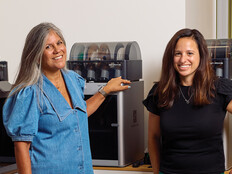Review: Eee Pad Transformer is More Than Meets the Eye
The anytime, anywhere access to Wi-Fi, a wide range of applications and rich online content that tablets deliver are appealing features, but many school IT managers are wary of committing to a device that's primarily suited for content consumption. Productivity-minded users typically turn to netbooks or notebooks instead.
ASUS offers the best of both worlds with the Eee Pad Transformer TF101.
End-User Advantages
ASUS packs a lot of punch into the Transformer's half-inch-thick, 1.5-pound form factor, making it comfortable for students of all ages. The device is powered by Google's Android 3.2 Honeycomb operating system, which was optimized for touch from its inception, and an Nvidia Tegra 2.1-gigahertz dual-core CPU. That, plus 1 gigabyte of RAM, provides enough power to handle the bounty of applications that Android Market offers. Flash-based web apps also run seamlessly on both the 16GB and 32GB versions.
The Transformer holds its own when compared with other tablets. But the optional keyboard docking station, which, for $125 more, extends the device's battery life to 16 hours, "transforms" it into the most compelling product I've seen in a long time. One moment, one of my students was using the Transformer as a tablet and playing a math game. The next, I was docking it, inserting a flash drive and opening a text document in the preinstalled mobile office productivity solution, which I then edited, saved and e-mailed.
The Transformer also sports two cameras: 1.2 megapixels in front, 5MP in the rear. I especially liked that the pictures and video I captured were easy to locate and view.
The docking station's SD card reader simplifies data transfer between devices, and two USB ports accept accessories. The track pad offers both left- and right-click functionality.
Why It Works for IT
ASUS incorporates custom software that IT managers will appreciate. Most notable is MyNet, which lets users stream digital media between the Transformer and Digital Living Network Alliance–compliant devices on the same network; and MyCloud, which gives users access to digital content stored in the cloud.
The Transformer's screen is made of Gorilla Glass, a Corning innovation known for its exceptional resistance to the scratches and drops that are inevitable in a classroom. The 10.1-inch display is bright and clear — even in broad daylight.
Disadvantages
Docking the Transformer can be tricky. If the user fails to correctly align the tablet with the docking station, the metal contact that protrudes from the dock could scratch the tablet's edge or cause it to bend inward. Users with flash drives need the docking station to employ them, since the tablet itself lacks USB ports.
By default, the Transformer uses the manufacturer's virtual keyboard rather than the Honeycomb keyboard, which is available as an option. I liked that the ASUS keyboard places the numeral keys at the top, eliminating the need to call up a secondary keyboard. But the ASUS keyboard also positions the row of keys beginning with "ASDF" directly above the row beginning with "ZXCV," rather than placing them slightly off-center (as other keyboards do). I couldn't get comfortable with this placement.
Buzz Garwood, a sixth-grade teacher at Coronita Elementary School in Corona, Calif., writes the This Week in Ed Tech blog (thisweekinedtech.com) in his spare time. He also blogs and produces videos for EdTech magazine's website and is a contributing writer for BYTE.








